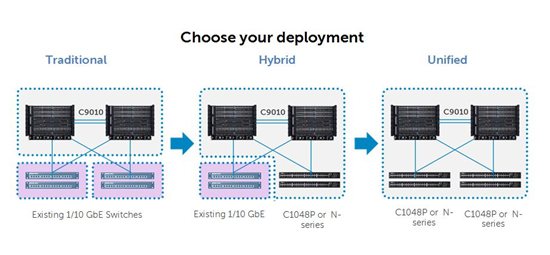The exponential increase in user devices requiring access to enterprise networks presents an unprecedented burden on network infrastructures and an ongoing threat to security. In addition, applications such as Microsoft Lync and cloud services such as Salesforce.com and SAP Cloud are changing network traffic patterns and are exhausting bandwidth.
A major reason that traditional networks are struggling to meet the rapidly changing enterprise environment is that the network architectures are inherently complex with multiple tiers, multiple operating systems and multiple CLI’s. Core and Aggregation Switches are managed separately and operate independently from access switches. When changes or upgrades are needed, every switch needs to be manually reconfigured. And, complex protocols such as spanning tree are required to manage network traffic.
We at Dell Networking strive to carry on Dell’s rich tradition of developing technology solutions that drive complexity out the enterprise. And today we are announcing the C9010 and C1048P, the first products based on an innovative Dell Networking architecture that will change how mid to large size campus networks and small to mid-size data centers build and manage their networks.
Why a new network architecture?
After extensive research, we have concluded that a significant portion of customer investment in separately managed core and access switches is going to waste. Access switches are being configured to support many functions when their job is to simply shuttle traffic to another layer in the network. These edge switches have significant operational overhead, however all of the functionality that is really needed is access-based security, QoS, PoE/PoE+ and simple loop detection/prevention. The rest of the functions can be managed at the network core.
Dell’s new architecture reduces complexity by collapsing network layers and allows access devices to be controlled by a single director switch. The innovative architecture allows customers to rapidly deploy new applications and simplifies wired/wireless management. In addition Dell’s new architecture is massively scalable- delivering a single switch for an enterprise network (up to 4,000 ports).
The C9010 modular switch acts as the central director of the network The C1048P rapid access nodes are 1Ge or 10Ge edge switches that can be stacked and can be connected to multiple C9010 switches for redundancy. Once the access node is connected to the C9010, it gets its configuration and starts functioning.
Another key benefit of the new architecture is a single point for security management. With an integrated firewall leveraged from SonicWall, customers can meet PCI requirements and enforce corporate security policies.
Customer Reaction
We are very encouraged by the positive feedback we have received from our customers who have seen the C9010 up-close. We are looking forward to presenting the new architecture to all of the attendees at Dell World in October. We believe our customers will embrace:
- A networking system that reduces management complexity, allowing administrators to build and maintain the entire network from a single device.
- A Future-ready architecture that is software defined, multi-rate and granular, allowing customers to accommodate the influx of new devices and applications
- Economical scalability that allows customers to expand capacity while preserving existing investments in Dell Networking and other industry standard switches
Be sure to follow @DellNetworking for all the latest on our product and solutions offerings, and we hope you can visit with us this October at Dell World!
* Although many customers will begin with a traditional or hybrid deployment, the full benefits of this new architecture are realized when a customer deploys the C9010 with C1048P rapid access nodes. Shortly after introducing the C9010 and C1048P, we will enable via software, the N2000 and N3000 to be converted into rapid access nodes, allowing customers who have previously deployed N2000 and N3000 products to have them participate in this new architecture. Moving forward, any new Dell Networking products that support IEEE 802.1br would be candidates to have this new technology enabled.

